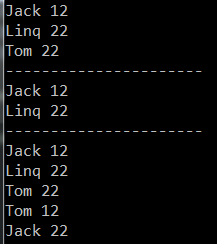在Linq中应用委托作为相等比较
日期:2014-05-20 浏览次数:21124 次
在Linq中使用委托作为相等比较
Linq中的操作符的相等比较都使用IEqualityComparer<T>作为判断依据,常见的使用该接口的操作符有:
Distinct<TSource>(IEnumerable<TSource>, IEqualityComparer<TSource>) Contains<TSource>(IEnumerable<TSource>, TSource, IEqualityComparer<TSource>)使用该接口固然可以进行自定义的相等比较,但若对同一类型要做多种相等比较则需要继承实现IEqualityComparer<T>接口的多个子类型,这对于像我这样懒惰的程序员是很难接受的。
如果有一个Person类定义如下:
class Person
{
public string Name { get; set; }
public int Age { get; set; }
}而有一个Person[]数组名为people,在代码中我希望这样使用Linq查询:
var age = people.Distinct((x, y) => x.Age == y.Age); var nameandage = people.Distinct((x, y) => (x.Age == y.Age) && (x.Name==y.Name))利用委托实现自定义的相等操作,不论是灵活性还是可读性都要好得多,下面我就要为了写成这样的代码而做做工作了。
首先,要定义一个泛型类去实现IEqualityComparer<T>接口,此外,对该类的要求是要能接受委托比较器,下面即是实现的代码:
public static class MyLinqOperandExtensions
{
private class DelegateComparer<T> : IEqualityComparer<T>
{
private readonly Func<T, T, bool> comparator;
public DelegateComparer(Func<T, T, bool> comparator)
{
this.comparator = comparator;
}
public bool Equals(T x, T y)
{
return comparator(x, y);
}
public int GetHashCode(T obj)
{
return 1;
}
}
}然后,就是需要一个自定义的Distinct操作符,为了和.NET的操作符区分开来,我是用MyDistinct作为新名称:
public static class MyLinqOperandExtensions
{
public static IEnumerable<T> MyDistinct<T>(this IEnumerable<T> source, Func<T, T, bool> comparator)
{
if (source == null)
throw new ArgumentNullException("source");
if (comparator == null)
throw new ArgumentNullException("comparator");
return source.Distinct(new DelegateComparer<T>(comparator));
}
} 现在,我们就可以使用委托来使用Distinct操作了,如下示例:
Person[] people = new Person[] {
new Person{Name="Jack",Age=12 },
new Person{Name="Linq",Age=22 },
new Person{Name="Tom",Age=22 },
new Person{Name="Tom",Age=12 },
new Person{Name="Jack",Age=22 }
};
var name = people.MyDistinct((x, y) => x.Name == y.Name);
foreach (var n in name)
Console.WriteLine("{0} {1}", n.Name, n.Age);
Console.WriteLine("----------------------");
var age = people.MyDistinct((x, y) => x.Age == y.Age);
foreach (var n in age)
Console.WriteLine("{0} {1}", n.Name, n.Age);
Console.WriteLine("----------------------");
var nameandage = people.MyDistinct((x, y) => (x.Age == y.Age) && (x.Name==y.Name));
foreach (var n in nameandage)
Console.WriteLine("{0} {1}", n.Name, n.Age); 运行结果如图1:

图1
类似的,我们还可以实现Contains操作符,这里就不再赘述了。
免责声明: 本文仅代表作者个人观点,与爱易网无关。其原创性以及文中陈述文字和内容未经本站证实,对本文以及其中全部或者部分内容、文字的真实性、完整性、及时性本站不作任何保证或承诺,请读者仅作参考,并请自行核实相关内容。
